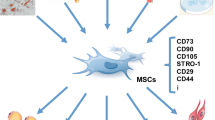Abstract
Human adipose-derived stem cells (hADSCs) have the ability to influence immune response, and hence are key cell sources for tissue repair and regeneration. In this study we explored the effect of continuous passage on the immunomodulatory properties of hADSCs to provide some advises for large-scale production of hADSCs for clinical applications. We found that after continuous passage, the specific surface markers expression levels as well as the adipogenic and osteogenic differentiation capacities of hADSCs had no obvious changes. However, the secretion levels of IL-10 and HGF reduced dramatically along with passage numbers. Furthermore, the INF-γ level was found higher in which medium peripheral blood mononuclear cells were co-cultured with hADSCs with higher passage numbers. Also, the in vivo experiments showed that the peritonitis model mice, which were injected with higher passage numbers of hADSCs, tended to have higher levels of inflammation. All these together indicated that continuous passage has only minor effect on the cell phenotypes but will impair the immunomodulatory properties of hADSCs. This suggests that hADSCs could be prepared by continuous passage, but only those cells of lower passage numbers would be ideal therapeutic tools.




Similar content being viewed by others
References
Bai L, Lennon DP, Eaton V, Maler K, Caplan AI, Miller SD, Miller RH (2009) Human bone marrow-derived mesenchymal stem cells induce Th2-polarized immune response and promote endogenous repair in animal models of multiple sclerosis. Glia 57:1192–1203
Bartosh TJ, Ylöstalo JH, Mohammadipoor A, Bazhanov N, Coble K, Claypool K, Lee RH, Choi H, Prockop DJ (2010) Aggregation of human mesenchymal stromal cells (MSCs) into 3D spheroids enhances their antiinflammatory properties. Proc Natl Acad Sci USA 107:13724–13729
Ben-Ami E, Berrih-Aknin S, Miller A (2011) Mesenchymal stem cells as an immunomodulatory therapeutic strategy for autoimmune diseases. Autoimmun Rev 10:410–415
Caplan AI (2007) Adult mesenchymal stem cells for tissue engineering versus regenerative medicine. J Cell Physiol 213:341–347
Cho HH, Park HT, Kim YJ, Bae YC, Suh KT, Jung JS (2005) Induction of osteogenic differentiation of human mesenchymal stem cells by histone deacetylase inhibitors. J Cell Biochem 96:533–542
Choi H, Lee RH, Bazhanov N, Oh JY, Prockop DJ (2011) Anti-inflammatory protein TSG-6 secreted by activated MSCs attenuates zymosan-induced mouse peritonitis by decreasing TLR2/NF-κB signaling in resident macrophages. Blood 118:330–338
Dicker A, Le Blanc K, Aström G, van Harmelen V, Götherström C, Blomqvist L, Arner P, Rydén M (2005) Functional studies of mesenchymal stem cells derived from adult human adipose tissue. Exp Cell Res 308:283–290
Frimodt-Møller N (1993) The mouse peritonitis model: present and future use. J Antimicrob Chemother 31:55–60
Götherström C, Ringdén O, Westgren M, Tammik C, Le Blanc K (2003) Immunomodulatory effects of human foetal liver-derived mesenchymal stem cells. Bone Marrow Transplant 32:265–272
Kim JH, Jung M, Kim HS, Kim YM, Choi EH (2011) Adipose-derived stem cells as a new therapeutic modality for ageing skin. Exp Dermatol 20:383–387
Klyushnenkova E, Mosca JD, Zernetkina V, Majumdar MK, Beggs KJ, Simonetti DW, Deans RJ, Mclntosh KR (2005) T cell responses to allogeneic human mesenchymal stem cells: immunogenicity, tolerance, and suppression. J Biomed Sci 12:47–57
Le Blanc K (2003) Immunomodulatory effects of fetal and adult mesenchymal stem cells. Cytotherapy 5:485–489
Mallone R, Mannering SI, Brooks-Worrell BM, Durinovic-Belló I, Cilio CM, Wong FS, Schloot NC (2011) Isolation and preservation of peripheral blood mononuclear cells for analysis of islet antigen-reactive T cell responses: position statement of the T-Cell Workshop Committee of the Immunology of Diabetes Society. Clin Exp Immunol 163:33–49
Ness TL, Hogaboam CM, Strieter RM, Kunkel SL (2003) Immunomodulatory role of CXCR2 during experimental septic peritonitis. J Immunol 171:3775–3784
Noël D, Caton D, Roche S, Bony C, Lehmann S, Casteilla L, Cousin B (2008) Cell specific differences between human adipose-derived and mesenchymal–stromal cells despite similar differentiation potentials. Exp Cell Res 314:1575–1584
Rasmusson I (2006) Immune modulation by mesenchymal stem cells. Exp Cell Res 312:2169–2179
Schwab JM, Chiang N, Arita M, Serhan CN (2007) Resolvin E1 and protectin D1 activate inflammation-resolution programmes. Nature 447:869–874
Shi Y, Su J, Roberts AI, Shou P, Rabson AB, Ren G (2012) How mesenchymal stem cells interact with tissue immune responses. Trends Immunol 33:136–143
Wang J, Ye Y, Tian H, Yang S, Jin X, Tong W, Zhang Y (2011) In vitro osteogenesis of human adipose-derived stem cells by coculture with human umbilical vein endothelial cells. Biochem Biophys Res Commun 412:143–149
Wen Z, Liao Q, Hu Y, Liu S, You L, Zhao Y (2013) Human adipose-derived stromal/stem cells: a novel approach to inhibiting acute pancreatitis. Med Hypotheses 80:598–600
Zhang X, Wu M, Zhang W, Shen J, Liu H (2010) Differentiation of human adipose-derived stem cells induced by recombinantly expressed fibroblast growth factor 10 in vitro and in vivo. In Vitro Cell Dev Biol Anim 46:60–71
Zhao RC, Liao L, Han Q (2004) Mechanisms of and perspectives on the mesenchymal stem cell in immunotherapy. J Lab Clin Med 143:284–291
Acknowledgments
The work was funded by China postdoctoral science foundation (2013M532197).
Author information
Authors and Affiliations
Corresponding author
Additional information
Xiyou Wang and Cuilong Liu have contributed equally to this work.
Rights and permissions
About this article
Cite this article
Wang, X., Liu, C., Li, S. et al. Effects of continuous passage on immunomodulatory properties of human adipose-derived stem cells. Cell Tissue Bank 16, 143–150 (2015). https://doi.org/10.1007/s10561-014-9451-z
Received:
Accepted:
Published:
Issue Date:
DOI: https://doi.org/10.1007/s10561-014-9451-z




